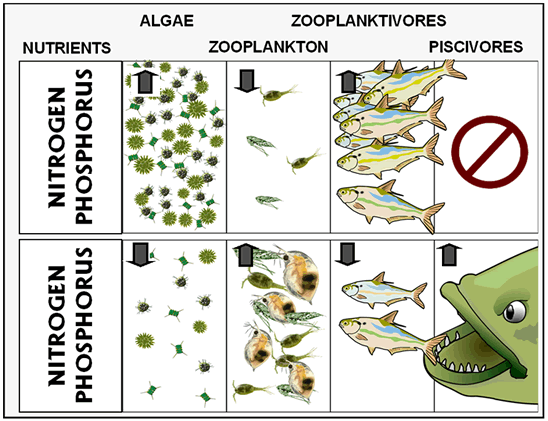Top Down vs. Bottom Up
The Lakes of Missouri Volunteer Program tests for nitrogen and phosphorus, the nutrients primarily responsible for algae growth. We tell anyone who will listen that if you want to control algae, you must control the nutrients. However, it is possible to alter the amount of algae in a lake by manipulating fish populations.
To understand how this works, it’s important to understand the role of various organisms in the food web.
The Trophic Cascade
Each box in the graphic to the right represents a “trophic” level, or food group from nutrients to piscivores. Altering the higher trophic levels (e.g. piscivores) can lead to a “cascade” effect on the lower trophic levels. For example, a lack of piscivores usually results in an abundance of zooplanktivores and algae (top row), while an increase in the number of piscivores eventually results in a decrease in the number of zooplanktivores and, theoretically, algae (bottom row). By adding piscivores, the grazing pressure is removed from the zooplankton and their numbers should increase. As a result, the algae population is more thoroughly grazed. The nutrients are generally not affected by this “biomanipulation.”
The Trophic Cascade in Freshwater Systems
Nutrients (Nitrogen and Phosphorus)
For algal growth in lakes, nutrients of primary concern are nitrogen and phosphorus, “macronutrients” that establish the upper limit for algae growth in a lake. Factors such as grazing by zooplankton, temperature and available sunlight can prevent algal growth from reaching its maximum potential, but high levels of algal biomass will not occur in the absence of sufficient nutrients.
Algae
These organisms are the base of the aquatic food web. Lakes receiving excess nutrients from human impacts tend to have too much algae. This abundance causes numerous problems, many of which have been outlined in previous issues of the Water Line.
Zooplankton
This group of small animals eats algae and provides forage to small planktivorous fish. In some cases, zooplankton can filter the entire volume of water in a lake in just a few days. In the presence of planktivorous fish, the zooplankton tend to be small because bigger zooplankton are easier to see (and therefore easier to eat). In the absence of grazing pressure by zooplanktivores, the zooplankton community will shift toward larger species. It is important to note that zooplankton don’t usually eat blue green algae, filamentous algae or algae attached to rocks or other structures.
A cladoceran and a copepod. Two examples of zooplankton
Zooplanktivores
This trophic level includes shad and shiners. These fish will consume the zooplankton that keep algae populations in check. Reducing the numbers of these fish will theoretically increase the number (and size) of zooplankton in the lake and ultimately lead to lower concentrations of algae.
Gizzard shad are zooplanktivores, or animals that eat zooplankton.
Piscivores
“Fish eaters”, like largemouth bass or walleye, are at the top of the freshwater aquatic food chain. Piscivores can eat zooplanktivorous fish in great enough quantities to affect the zooplankton population. Thanks to reduced pressure from the zooplanktivores, the zooplankton increase in number and size and can more readily consume algae, resulting in clearer water in some cases.
A piscivore, or a fish that eats fish
Top Down vs. Bottom Up
Each group, such as the algae, zooplankton or piscivores, has a functional role in the ecosystem. When you attempt to reduce nutrients to control algae, you are working from the “bottom-up,” the method that most consistently works for controlling algae. However, it is possible to approach the problem from the other end and work from the “top-down.” Increasing or decreasing the numbers of consumers (organisms that eat other organisms) to control the numbers of lower level organisms is called biomanipulation.
Biomanipulation Techniques
One way to reduce the numbers of zooplanktivores is to poison the lake. While this option is generally unappealing, it is the most reliable biomanipulation technique for increasing zooplankton and reducing algae. Another method is to drag a trawl net through the lake and sort the undesirable from the desirable fish; however, this is a labor intensive approach. Yet another method of bolstering the zooplankton community is to add bigger fish (i.e. piscivores) to eat the zooplanktivores.
The approach of adding more piscivores is very appealing to lake managers, because of the benefit of additional fishing opportunities. However, the success rate of this management approach as an algae control technique is questionable. One of the issues is that nearly all fish eat zooplankton at some point in their lives. Even largemouth bass fry will eat zooplankton until they grow enough to eat larger food items. Another concern is that the inherent variability in natural systems is amplified with each trophic level involved in the process. As a result, the effect of biomanipulation decreases with each trophic level that exists between the intended target and the manipulated species. For example, if you want to decrease algae via biomanipulation, you will likely have a stronger response if you directly alter zooplankton rather than piscivores.
In some cases, increased zooplankton abundance can result in reduced phosphorus concentrations. Zooplankton consume algae and the nutrients contained within the algae. As the zooplankton die, they sink to the bottom, taking whatever nutrients they have in their bodies with them. However, the impact of these nutrient reductions is negligible in most cases.
Top-down efforts to control algae aren’t always successful when used alone, and when they are successful, the results aren’t reliably predictable. This is especially true in the eutrophic (nutrient rich) lakes typically found in Missouri. In the presence of both excess nutrients and numerous zooplankton, the algal community is likely to be restructured rather than reduced. As zooplankton consume green algae and diatoms, less desirable blue green algae may begin to dominate the algae community. The overall consensus seems to be that biomanipulation efforts are most successful when executed in conjunction with “bottom up” controls, such as reducing the inputs of nutrients to the lake.
It always seems to come back to the nutrients!






